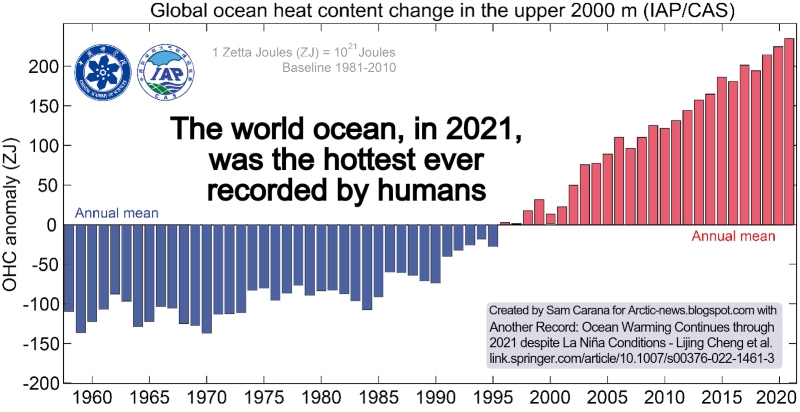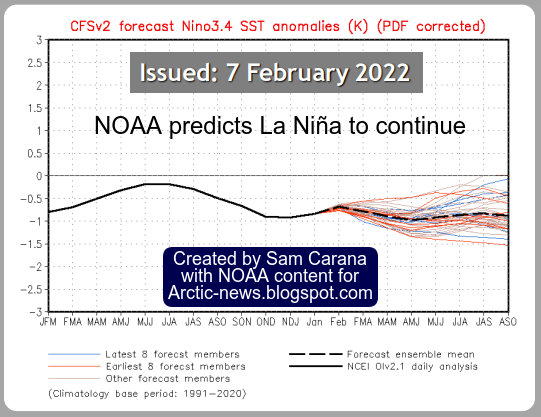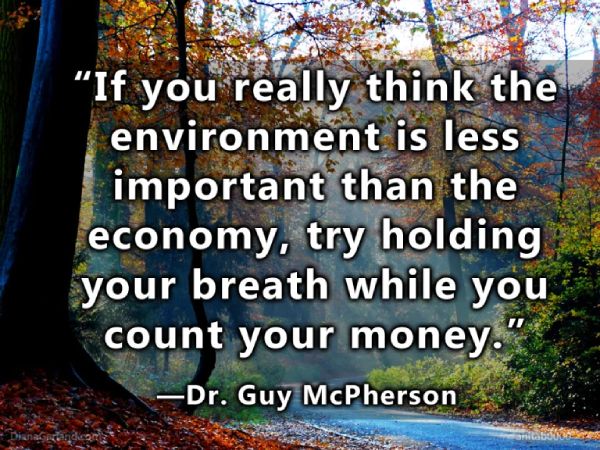Ocean heat is at record levels. As a result, global sea ice extent was only 16.23 million km² on February 9, 2022, the third lowest extent on record. What makes this even more worrying is that we're currently in the depth of a persistent La Niña.


Ocean heat is a huge threat for Antarctica at the moment. Antarctic sea ice extent now is at record low.

Above image shows that Antarctic sea ice extent was only 2.342 million km² on February 9, 2022, a record low for the time of year.

Ocean heat is reducing the sea ice around Antarctica and is getting underneath floating sea ice.
The Thwaites Glacier, which is on a retrograde slope, is especially vulnerable to collapse.
The Thwaites Glacier contains enough ice to raise global sea levels by 65 cm (25.59 inches)if it were to completely collapse.

The animation above, created with images from Climate Reanalyzer, shows the retreat of the Antarctic snow and ice cover from January 8 to February 9, 2021.
Another danger of a rapid loss of the snow and ice cover on Antarctica is release of methane. Jemma Wadham warned about this in a 2012 study, as discussed at the post methane hydrates. More recently, Jemma Wadham said: “We are sleepwalking into a catastrophe for humanity.”
A recent study concludes that mountain glaciers may hold less ice than previously thought. Their disappearance means less water for drinking and agriculture, and faster temperature rises due to albedo loss. While the study found that the Himalayas contain more water than thought, another recent study, Mt. Everest’s highest glacier is a sentinel for accelerating ice loss, describes how human-induced climate change has a huge impact on the highest reaches of the planet.
The outlook for the Arctic is most threatening, as the post methane hydrates also concluded back in 2013, as described in numerous post here at Arctic-news and as discussed in the video below by Jim Massa.

As said, we're currently in the depth of a persistent La Niña, which suppresses temperatures. The difference between the top of El Niño and the bottom of La Niña could be more than half a degree Celsius.

The threatening situation is that we'll go into the next El Niño, while sunspots are increasing and while the aerosol impacts may go from dimming into further driving up temperatures. A huge temperature rise could occur as the sulfates fall away that are currently co-emitted by traffic and industry, while at the same time releases of other aerosols such as black and brown carbon can increase dramatically as more wood burning and forest fires take place.
In a giant scheme of deception, the temperature rise is all too often presented with images of people playing on the beach on a 'warm' day, as if 'global warming' was making life more 'comfortable'.
Forest fires are called 'wildfires', biomass burning and associated deforestation is referred to as 'renewable biofuel', fracking-induced earthquakes are called 'natural' disasters and methane eruptions are called seeps and bubbles of 'natural' gas from 'natural' sources such as wetlands.
This gives the false impression that this was somehow 'natural' as if human activities had nothing to do with it, and as if owning beach-front property was becoming ever more attractive.
In reality, human-caused emissions have a huge short-term impact on temperature and - especially when combined with genuinely natural variability such as El Niño and sunspots - they can act as a catalyst, causing numerous feedbacks to kick in with ever greater ferocity.
This can result in collapse of global sea ice and permafrost, resulting in the eruption of huge quantities of carbon dioxide, methane and nitrous oxide, further driving up the temperature rise abruptly, as described at the extinction page. Further feedbacks are also described at the feedbacks page.
Links
https://link.springer.com/article/10.1007%2Fs00376-022-1461-3
https://www.nature.com/articles/nature11374
• Mountain glaciers may hold less ice than previously thought – here’s what that means for 2 billion downstream water users and sea level rise
https://theconversation.com/mountain-glaciers-may-hold-less-ice-than-previously-thought-heres-what-that-means-for-2-billion-downstream-water-users-and-sea-level-rise-176514
• Ocean Heat Content Update 1 - 2022 - Science Talk with Jim Massa
https://www.youtube.com/watch?v=pctkg_LDqcU
• NOAA - Solar Cycle Progression
https://arctic-news.blogspot.com/p/climateplan.html








